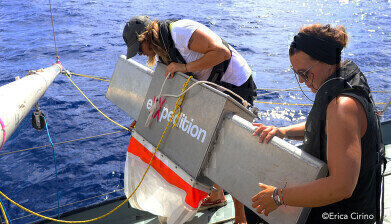-
 A manta trawl used to sample microplastics RTW eXXpeditionLeg2 (© eXXpedition Erica Cirino194)
A manta trawl used to sample microplastics RTW eXXpeditionLeg2 (© eXXpedition Erica Cirino194) -
-RTW1_7.jpg) Crew member studying microplastic (Picture Credit eXXpedition and Nomad Neumonics)
Crew member studying microplastic (Picture Credit eXXpedition and Nomad Neumonics)
Water/Wastewater
New study demonstrates how microplastic particles differ across the Atlantic Ocean
Nov 23 2022
The waters of the North Atlantic gyre contain significantly greater quantities of plastic – composed of polymers arising from packaging, rope, and paint particles – than other areas of the open ocean, according to new research.
One of the planet’s five great oceanic gyres, manmade marine debris becomes trapped in a circular ocean current that stretches from the east coasts of North America to the west coasts of Europe and Africa.
A new study, published in Marine Pollution Bulletin, has found it contains higher levels of polyethylene, polypropylene, acrylic, and polyamide, whereas other offshore locations are more associated with PVC and polystyrene.
Seawater closer to land, on the other hand, contains far more diversity in its polymer composition, with researchers saying this could potentially be influenced by its proximity to a variety of sources of plastics arising from land.
The study was conducted by researchers from the University of Plymouth, Mercator Ocean International, and eXXpedition, with samples collected during eXXpedition's pioneering all-women Round the World sailing mission.
Its findings are based on almost 30 samples taken across the Atlantic Ocean, enabling scientists to examine variations in microplastic concentration and types within the upper ocean, both on the surface and to a depth of 25 metres.
The overall aim of the research was to provide further data of plastic quantities in the region, and also to cover parts of the ocean where existing data was sparse, such as the eastern boundary of the North Atlantic gyre.
Dr Winnie Courtene-Jones, eXXpedition Science Lead and Post-Doctoral Research Fellow in the International Marine Litter Research Unit at the University of Plymouth, is the study’s lead author.
She said: “The presence of plastic pollution within the North Atlantic, and its subtropical gyre, have been reported for 50 years. However, this research shows that the types of polymers differ between different regions of the North Atlantic. The high diversity of polymers identified in inshore waters may simply be down to the numerous and varied source of plastic inputs coming directly from land, Meanwhile the gyre appears to be more closely associated with items that may come from maritime industries or been transported from the countries which border the Atlantic Ocean via ocean currents.“
The water samples collected in the gyre contained on average 0.62 microplastics per m3 of sea water, compared with an average of 0.19MP/m3 in other areas of open ocean, and 0.4MP/m3 in inshore areas.
By using tracking models developed by experts at Mercator Ocean International, the research team was able to demonstrate how particles found on the surface of the gyre might have reached this region.
Taking into account the hugely varied currents in the North Atlantic, the models suggest they could have entered the sea from anywhere in North America, western Europe and north western Africa.
This, the researchers say, also indicates some of the challenges when attempting to manage the flow of plastic pollution from source to sea.
eXXpedition’s Round the World voyage left Plymouth in October 2019 to visit some of the most important and diverse marine environments on the planet with the aim of inspiring a network of changemakers, informing effective solutions with industry and influencing policy change on land.
Emily Penn BEM, eXXpedition Founder and one of the co-authors on the current study, said: “The remarkable discovery from our research was the huge diversity of polymer types, particularly in the inshore regions. It tells us that the pollution has come from many different sources – be it clothing, paint fragments or car tyres – and as a result means the solutions need to be diverse too. We set out to pinpoint where the solutions lie on land by better understanding the location the pollution had come from in the first place, but in fact the results just reinforce how much of an international challenge this is. The ocean connects us all and your pollution is my pollution – we need to solve it together.”
Digital Edition
AET 28.3 September 2024
September 2024
Business News - ENVEA announces acquisition of APAQ Group - SICK and Endress+Hauser sign strategic partnership - Efforts to curb gas flaring intensify amid environmental concerns Air Monito...
View all digital editions
Events
WEATHER • CLIMATE • WATER / EARTH OBSERVATIONS / GREEN ECONOMY
Oct 29 2024 St. Petersburg, Russia
Oct 30 2024 Hong Kong
Nov 05 2024 Toronto, Canada
Nov 05 2024 Rimini, Italy
Nov 06 2024 Ho Chi Minh City, Vietnam
.jpg)

















